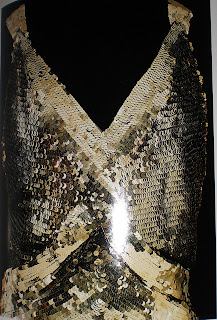Embellishment being the main theme of my whole Project, I sought after different types of trimmings used to simply Spice up a garment or work covertly as a functional element.
Sequins are ornamental disk-shaped beads used for decorative purposes of Garments; mainly used for theatrical or dance purposes.
The Sequin intends to catch the light and reflect it back. Available in a variety of sizes, colours and geometrical shapes, Sequins have proved to be a Trend that comes and goes; as I had noticed in 2009 the upcoming rise of its popularity. ‘The Black Sequin Dress’ came very popular last year.
The History of Sequins
In the 1940’s gelatine was a discovered material and used to create Sequins. Soon after, there were complications with the material. It was found that Gelatine could not be near heat or water so clothing with gelatine surfaces could not be laundered.
A new plastic was tried. Eastman Kodak created acetate for film stocking. It was a clear plastic plated on one side with real silver. Kodak customised acetate for Algy’s manufacturing Company (where sequins were produced). They coated on the silver with a clear ink of the desired colour. In effect, it was suitable for use and the light would penetrate through the colour, hit the silver and reflect back.
Plastic sequins were steadier than gelatine sequins but they would still melt in the sun and tarnish in the rain.
Algy Lieberman established Sequin production in the USA
Algy says:
We had to get around that eventually, it took many, many years. We experimented with different methods, what we came up with was a sandwich.
Mylar was an invention by Dupont Corporation around WW11. Algy decided to use a very thin piece of clear Mylar to wrap around a Sequin. The Mylar worked as a protector of the colouring.
This made the Sequin machine washable!
Sequins have also been used to embellish the clothing of Royalty in the past.
It is rumoured that Gold Sequins were found in King Tut’s Tomb; intended for him to be well dressed in the afterlife.
These Egyptian sequins were made of ornate Gold rolled thin, cut out and hung. They then glazed the gold to prevent scratches and chips.
There are also Vintage Sequins. They were designed using Mother of Pearl, metals, crystals, celluloid or various other plastics.
Today:
Sequins are normally made out of vinyl plastic because it is easier to work with and is not brittle in texture. The plating adheres to it better because it has a softer surface. However, it will curl up over time because vinyl has a memory. Nowadays, Sequins are fairly popular with people having their own preferences. I would say that it is still widely associated with Glamour.
Effect:
Sequined garments gave off the idea of being very expensive and the impression of you had to firstly own a lot of money and be of a high status to wear clothes with Sequins. This probably was the case as it was very hard to make sequins back then therefore not a lot of people wore it making it rather exclusive. It could turn the most ordinary thing into a very stylish and intriguing piece. I think the main word associated with Sequins is GLAMOUR.
It causes me to imagine Hollywood
I really admire the use of Silver, Gold or Black sequins because they seem more appealing to me and really define elements of garments.
They are really cute and can be used for smaller areas; they could be used on bags as well as jewellery.






No comments:
Post a Comment